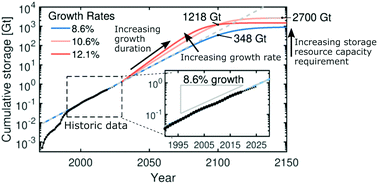Global geologic carbon storage requirements of climate change mitigation scenarios†
Abstract
Integrated assessment models have identified carbon capture and storage (CCS) as an important technology for limiting climate change. To achieve 2 °C climate targets, many scenarios require tens of gigatons of CO2 stored per year by mid-century. These scenarios are often unconstrained by growth rates, and uncertainty in global geologic storage assessments limits resource-based constraints. Here we show how logistic growth models, a common tool in resource assessment, provide a mathematical framework for stakeholders to monitor short-term CCS deployment progress and long-term resource requirements in the context of climate change mitigation targets. Growth rate analysis, constrained by historic commercial CO2 storage rates, indicates sufficient growth to achieve several of the 2100 storage targets identified in the assessment reports of the Intergovernmental Panel on Climate Change. A maximum global discovered storage capacity of approximately 2700 Gt is needed to meet the most aggressive targets, with this ceiling growing if CCS deployment is delayed.



 Please wait while we load your content...
Please wait while we load your content...